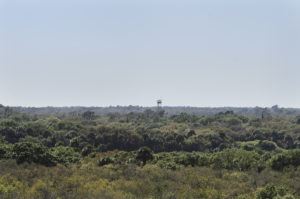

For 13 years, Charlie Womer climbed to the top of Mehoopany fire lookout tower in Wyoming County to watch over miles of countryside.
The tower went up in 1923. Womer was born four years later.
Fire season is changing for Womer and the tower he watched from.
Last year was his last season watching for forest fires, and the tower is scheduled to be replaced.
“I enjoyed it,” he said. “I miss going up the tower and looking around.”
Last year, at 88 years old, Womer was still climbing the steep flights of metal stairs to the top of the Mehoopany fire tower, crawling through the hatch and watching the landscape.
It’s a rare position among the hundreds of men and women who care for the state’s natural resources. About ten towers are actively staffed at a time, and in many cases, the person watching on a particular day is a DCNR employee who normally does other work but is assigned to work in the tower that day.
Womer began the job after Jack Zborovian, a DCNR fire supervisor, asked fire chiefs in the area if they knew people who might be interested in the job. Womer, the former president of the Noxen Volunteer Fire Company, applied in Scranton for the position, which pays $13-$18 per hour, with all the scenic views you want.

From his post in a small cabin 60 feet above the ground, Womer could see puffy clouds from the Susquehanna Steam Electric Station nuclear power plant, windmills in Bear Creek 25 miles away, and into Broome County, New York.
He worked during spring, when Pennsylvania sees more than 80 percent of its wildfires. Each day, he spent eight hours in the tower when fire danger was highest, from late morning until the evening. He saw farmers getting ready for planting and the remnants of winter snow making shiny white lines on the runs of Montage Mountain ski resort. He once pinpointed the location of a fire by explaining what ski run it was on.
He was there as windmills at the Mehoopany Wind Farm went up. When they were complete, he heard the steady whoosh of the windmills spinning all around him.
About half the time Womer was up in the tower, he was monitoring an active fire, or sometimes more than one. The rest of the time was spent watching for flames.
Couldn’t that get boring?
“It didn’t with me,” he said. He was interested in the wildlife around his perch – deer, turkey, bear, everything – when fires weren’t threatening.
His observations went in a journal that kept a record of the fires he spotted. As he watched over the brown and green colors of the Pennsylvania countryside, he looked for the color of smoke.
When he saw it, he watched it for a moment. If it tapered off, it may be just a brush fire. If it got larger, it was probably a forest fire.
He turned to a circular map in the middle of the tower, looked out the windows and spun a metal rod until a point on the end lined up with the smoke.
He noted the direction from the tower to the smoke, and using measurements on the rod, an idea of how far away the fire was.
He might call another fire tower to see if the watcher there saw smoke in the same area. With two watchers looking at the same plume of smoke, a line from both of them should cross at the source of the fire.
If the smoke was far away and beyond the sight of another tower, Womer might pull out a regional or state map for more information, and call in the fire.
A local fire department is usually the first to check out the scene, and if it can handle the blaze alone, it extinguishes the fire and prepares for the next one. Sometimes they need aid. In that case, the firefighters start working to fight the fire, buying time for a DCNR crew to join them.
If it gets even larger, DCNR supervisor Jack Zborovian has a plan for calling in more resources, such as airplanes, bulldozers or more help from elsewhere in the state.
Most of the wilderness fires in the state are smaller than 10 acres. In 2015, for example, firefighters extinguished about 750 fires that were smaller than 10 acres, about 60 between 10 and 99 acres, and four that were larger than 100 acres. Almost all the forest fires in Pennsylvania are caused by humans, who start fires by burning debris, sending sparks flying from power equipment, deliberately burning the forest and in other ways.
Fire watchers are still an important part of wildland firefighting, said DCNR officials.
Most forest fires are called in by people via cellphone, but some parts of the state don’t have cell coverage or many people living there or passing through. The state also uses aircraft to detect fires, but aircraft costs have gone up quite a bit in the past 15 years, Kern said. Towers fill in some of that coverage.
“I think we realized that you need multiple ways to detect fires and towers are just kind of part of the puzzle,” he said.
Towers overlook areas with few roads and people, where someone on the ground would be unlikely to notice a fire until it has grown to become extremely large, Zborovian said.
“The towerman is basically our insurance policy to make sure that we get a first look at an early stage of a fire in that location,” he said.
Womer has stopped fighting wildfires, and now he’s stopped watching them. But he’s still involved in fire work, even as he turns 90 years old in May. He now helps with traffic control in support of firefighters working at a job he loves.